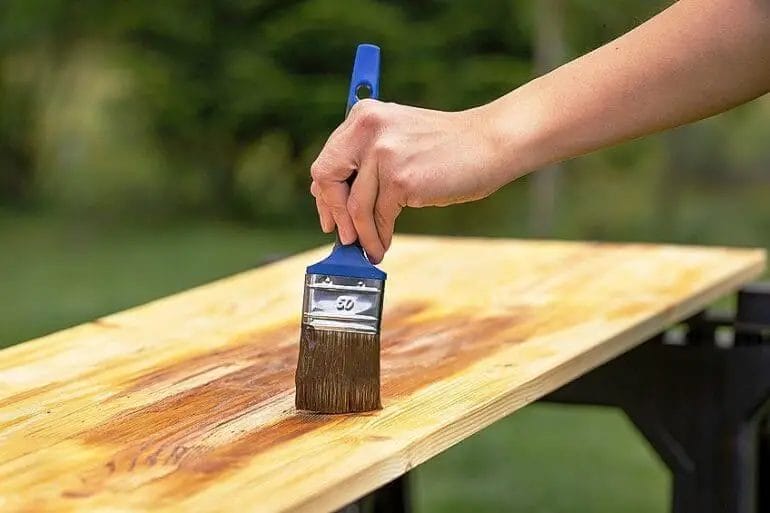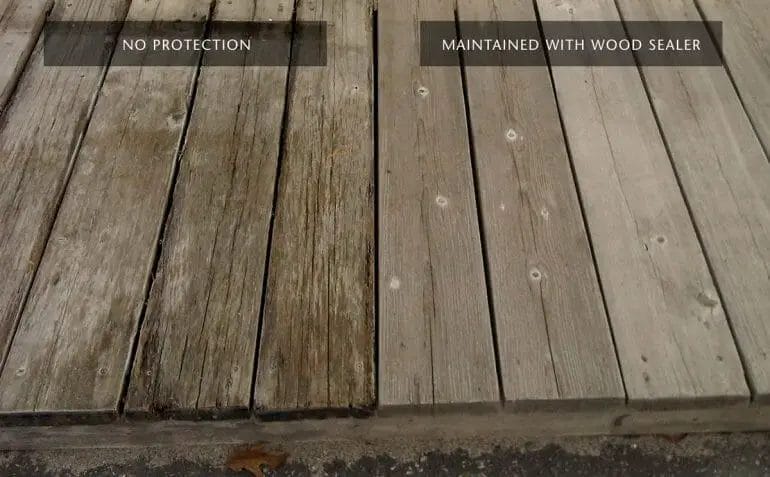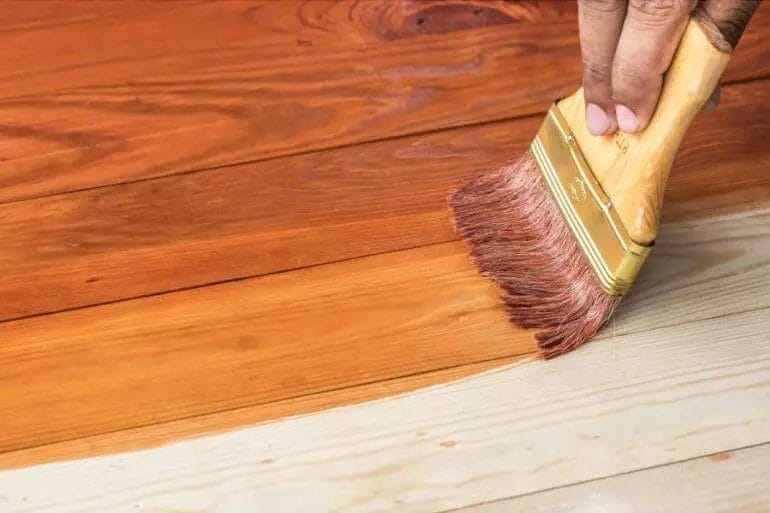A wood sealer is a protective coating applied to wood surfaces to enhance their durability and aesthetics.
It effectively seals the wood, preventing moisture, UV rays, and other external elements from causing damage such as rot, warping, or fading.

Wood sealers can be clear or tinted, allowing you to enhance the natural beauty of the wood or change its color.
Additionally, they provide a smooth and even finish, making the wood easier to clean and maintain.
Whether you are working on indoor or outdoor wood projects, using a wood sealer is essential to prolong the life of the wood and maintain its overall quality.

Different Types of Wood Sealers and Their Uses
Wood sealers are essential for protecting and enhancing the life and appearance of wood surfaces. They act as a barrier against moisture, UV rays, and other environmental factors that can damage the wood. Additionally, wood sealers can enhance the color and grain of the wood, giving it a more polished and attractive look. There are several types of wood sealers available in the market, each with its own unique characteristics and uses.
1. Clear Sealers
Clear sealers, also known as water repellents, are designed to protect wood from water damage. They penetrate deeply into the wood, creating a barrier that prevents water from seeping in. Clear sealers are typically used on decks, fences, and outdoor furniture. They preserve the natural color and texture of the wood while providing effective protection against moisture.
2. Stains
Wood stains are widely used for enhancing the color and grain of wood while also providing protection. They come in a variety of shades and can be transparent, semi-transparent, or opaque. Transparent stains allow the natural beauty of the wood to shine through while adding a subtle tint. Opaque stains provide a solid color finish and can completely conceal the wood grain. Stains are commonly used on interior and exterior wood surfaces such as floors, furniture, and cabinetry.
3. Varnishes
Varnishes are clear coatings that provide a glossy or satin finish to wood surfaces. They offer excellent protection against water, UV rays, and general wear and tear. Varnishes are commonly used on indoor wood surfaces such as floors, furniture, and trim. They enhance the natural beauty of the wood while providing a durable and long-lasting protective layer.
4. Shellac
Shellac is a natural wood sealer that is derived from the secretions of the female lac bug. It is available in liquid form and can be easily applied with a brush or rag. Shellac dries quickly and forms a hard, protective layer on the wood surface. It is commonly used on indoor wood surfaces such as furniture, cabinets, and musical instruments. Shellac offers good water and heat resistance but may not be as durable as other sealers.
5. Polyurethane
Polyurethane is a popular wood sealer that provides a strong and durable finish. It is available in both oil-based and water-based formulations. Oil-based polyurethane offers a rich and warm finish, while water-based polyurethane dries quickly and has a low odor. Polyurethane is commonly used on floors, furniture, and other high-traffic wood surfaces. It provides excellent protection against scratches, stains, and water damage.
6. Lacquer
Lacquer is a fast-drying wood sealer that forms a hard and durable finish. It is available in solvent-based and water-based formulations. Lacquer provides a clear and glossy finish that enhances the natural beauty of the wood. It is commonly used on furniture, cabinets, and other indoor wood surfaces. Lacquer offers good resistance to water, chemicals, and general wear and tear.
7. Epoxy
Epoxy is a versatile wood sealer that offers exceptional durability and moisture resistance. It is commonly used for sealing and protecting wood countertops, bar tops, and other high-moisture areas. Epoxy creates a thick and glossy finish that enhances the natural beauty of the wood while providing long-lasting protection. It is also resistant to stains, chemicals, and heat.
In summary, choosing the right wood sealer depends on the specific needs of your project. Clear sealers are ideal for protecting wood from water damage, stains enhance the color and grain of the wood, varnishes provide a glossy finish, shellac offers a natural and quick-drying option, polyurethane provides a strong and durable finish, lacquer gives a fast-drying glossy finish, and epoxy offers exceptional durability and moisture resistance. By understanding the different types of wood sealers and their uses, you can effectively protect and enhance the beauty of your wood surfaces.

Application Techniques for Achieving an Effective Wood Sealer Finish
When it comes to protecting and enhancing the natural beauty of wood, applying a wood sealer is an essential step. A wood sealer not only helps to prevent moisture penetration and damage but also adds a layer of protection against UV rays and other environmental factors. To achieve a flawless and effective wood sealer finish, it is important to follow the right application techniques. In this section, we will discuss some key techniques that can help you achieve the best results.
Clean and Prepare the Surface
Before applying any wood sealer, it is crucial to clean and prepare the surface properly. Start by removing any dirt, dust, or debris from the wood using a broom or vacuum cleaner. Then, scrub the surface with a mild detergent and water solution to remove any stains or grime. Rinse thoroughly and allow the wood to dry completely before proceeding with the sealer application. This step ensures that the sealer adheres properly and provides optimal protection.
Sand the Wood
Sanding the wood surface is an important step in achieving a smooth and even finish. Use sandpaper with a medium-grit (such as 120) to sand the surface in the direction of the wood grain. This helps to remove any roughness, unevenness, or imperfections from the surface. After sanding, use a tack cloth or a microfiber cloth to remove any sanding dust before applying the sealer.
Choose the Right Applicator
The choice of applicator plays a significant role in achieving an effective wood sealer finish. Different types of sealers may require different applicators, so it is important to choose the right one for the specific product you are using. Common applicators include brushes, rollers, and sprayers. Brushes are ideal for smaller areas and intricate details, while rollers are suitable for larger surfaces. Sprayers are often used for more even and efficient coverage. Ensure that the chosen applicator is clean and in good condition for optimal results.
Apply Thin and Even Coats
When applying the wood sealer, it is crucial to apply thin and even coats for the best results. Pour a small amount of sealer into a paint tray or container and dip the applicator into it. Remove any excess sealer by wiping it against the edge of the tray/container. Start applying the sealer in a methodical manner, following the direction of the wood grain. Work in small sections, applying the sealer evenly and avoiding overlapping or pooling. A second or third coat may be necessary depending on the specific sealer and desired level of protection.
Allow for Drying and Curing Time
After applying the wood sealer, it is important to allow sufficient drying and curing time for optimal results. This ensures that the sealer properly bonds with the wood and forms a durable protective layer. Follow the instructions provided by the manufacturer regarding the recommended drying and curing time. Avoid placing any objects or furniture on the treated surface until it is completely dry and cured.
Periodic Maintenance and Reapplication
To maintain the effectiveness of the wood sealer finish, periodic maintenance and reapplication may be required. Over time, the sealer may wear off due to exposure to weather conditions and regular use. Monitor the condition of the sealed wood and reapply the sealer as needed to ensure continued protection.
In summary, achieving an effective wood sealer finish involves proper surface preparation, sanding, choosing the right applicator, applying thin and even coats, allowing for sufficient drying and curing time, and periodic maintenance. By following these application techniques, you can enhance the durability and beauty of your wood surfaces for years to come.

How to Choose the Right Wood Sealer for Your Project
When working on a woodworking project, choosing the right wood sealer is essential to protect your wood and enhance its beauty. With so many options available in the market, it can be overwhelming to pick the right sealer for your specific project. In this section, we will discuss some factors to consider when choosing a wood sealer and provide you with a guide to help you make an informed decision.
1. Determine the Purpose of Your Project
The first step in choosing the right wood sealer is to determine the purpose of your project. Are you building outdoor furniture that will be exposed to harsh weather conditions? Or are you working on an indoor project that requires a more delicate touch? Understanding the purpose of your project will help you narrow down your options and choose a sealer that is suitable for your needs.
2. Consider the Type of Wood
The type of wood you are working with will also play a role in selecting the right sealer. Some woods, such as cedar or teak, naturally contain oils that make them more resistant to water and rot. On the other hand, softer woods like pine may require a sealer with extra protection to prevent damage. It is important to choose a sealer that is compatible with the type of wood you are using to ensure optimal results.
3. Evaluate the Level of Protection Needed
Another important factor to consider is the level of protection you need for your project. If you are working on an outdoor project, you will need a sealer that provides UV protection and is resistant to water, mold, and mildew. For indoor projects, a sealer that enhances the natural beauty of the wood and provides protection against stains and spills may be more suitable. Understanding the level of protection required will help you choose a sealer that meets your specific needs.
4. Research Different Types of Sealers
There are several types of wood sealers available in the market, each with its own unique properties. It is important to research and understand the different types of sealers before making a decision. Some common types include:
- Water-based sealers: These sealers are environmentally friendly, easy to clean up, and dry quickly. They are suitable for both indoor and outdoor projects.
- Oil-based sealers: These sealers provide a rich and warm finish to the wood. They are more durable and water repellent but take longer to dry.
- Polyurethane sealers: These sealers create a hard, protective coating on the wood surface. They are highly durable and resistant to wear and tear.
- Penetrating sealers: These sealers penetrate deep into the wood and provide long-lasting protection against moisture and UV rays.
By understanding the characteristics of each type of sealer, you can select the one that best suits your project requirements.
5. Consider Application and Maintenance
Before finalizing your choice, consider the application process and maintenance requirements of the sealer. Some sealers may require multiple coats for optimal results, while others may need periodic reapplication. It is important to choose a sealer that fits within your project timeline and maintenance capabilities.
In summary, choosing the right wood sealer for your project involves considering the purpose of your project, the type of wood being used, the level of protection needed, researching different types of sealers, and considering the application and maintenance requirements. By taking these factors into account, you can ensure that your wood project is properly protected and showcases its natural beauty for years to come.
Common Mistakes to Avoid when Applying Wood Sealer
Wood sealer is an essential product for protecting and enhancing the beauty of your wood surfaces. Whether you are working on a deck, furniture, or any other wooden structure, applying a sealer can help prevent damage from moisture, UV rays, and other hazards. However, it is important to apply the sealer correctly to ensure maximum effectiveness and longevity. Here are some common mistakes to avoid when applying wood sealer:
1. Skipping the Surface Preparation
One of the biggest mistakes people make is failing to prepare the wood surface properly before applying the sealer. It is crucial to clean the surface thoroughly to remove any dirt, dust, or previous coatings. Use a wood cleaner or deck wash to get rid of any mold, mildew, or stains. Sand the surface if necessary to smooth out any rough spots or imperfections. Proper surface preparation ensures that the sealer adheres well and provides optimum protection.
2. Overapplication
Applying too much sealer can actually be detrimental to the wood. Overapplication can lead to a thick, uneven coating that takes longer to dry and may result in a sticky or tacky finish. It is important to follow the manufacturer’s instructions regarding the recommended coverage rate. Apply the sealer in thin, even coats and avoid excessive buildup.
3. Underapplication
On the other hand, underapplying the sealer can leave the wood vulnerable to damage. It is important to ensure proper coverage to create a protective barrier. Read the instructions carefully to determine the recommended number of coats and coverage rate. Applying too few coats or not covering the entire surface may result in inadequate protection.
4. Not Allowing Sufficient Drying Time
Patience is key when it comes to applying wood sealer. Many people make the mistake of not allowing sufficient drying time between coats or before using the treated surface. Failure to let the sealer dry can lead to a compromised finish and may cause the sealer to peel, crack, or become discolored. Follow the manufacturer’s recommendations regarding drying time and avoid rushing the process.
5. Ignoring Weather Conditions
Weather conditions can greatly impact the effectiveness of wood sealer. Applying the sealer during extreme temperatures, high humidity, or in direct sunlight can affect the drying process and hinder proper adhesion. It is best to apply the sealer when the weather is mild and dry. Check the forecast and choose a time when there is no rain in the forecast for at least 24-48 hours.
Avoiding these common mistakes will help you achieve better results when applying wood sealer. Remember to always read and follow the manufacturer’s instructions, use the appropriate tools, and take the necessary precautions to protect yourself and the surrounding area. With proper application, wood sealer can prolong the life of your wood surfaces and keep them looking beautiful for years to come.
FAQs
What is a wood sealer?
A wood sealer is a protective coating applied to wood surfaces to prevent moisture, stains, and damage from penetrating the wood. It creates a barrier that helps extend the lifespan of the wood and enhances its natural beauty.
How does a wood sealer work?
A wood sealer works by penetrating deep into the wood fibers, filling any gaps or pores. It forms a protective layer on the surface of the wood, preventing moisture, UV rays, and other contaminants from causing damage. It also helps to reduce the chances of warping, cracking, and decay.
What are the benefits of using a wood sealer?
Using a wood sealer offers several benefits, including:
– Protection against moisture damage and rot
– Prevention of staining from spills and liquids
– Enhanced durability and longevity of the wood
– Protection against UV rays that can cause fading
– Preserving the natural beauty and grain of the wood
Conclusion:
In conclusion, wood sealer is a vital product for preserving and protecting wooden surfaces. By applying a wood sealer, you can enhance the durability and longevity of your wood furniture, flooring, or outdoor structures. This protective coating acts as a barrier against moisture, UV rays, and other environmental elements that can cause damage or deterioration. With regular maintenance and the use of a high-quality wood sealer, you can prevent warping, cracking, and rotting of your wood surfaces. Additionally, a wood sealer can enhance the natural beauty of the wood, bringing out its rich colors and grain patterns. Make sure to choose a suitable wood sealer based on the type of wood and intended use for optimal results.